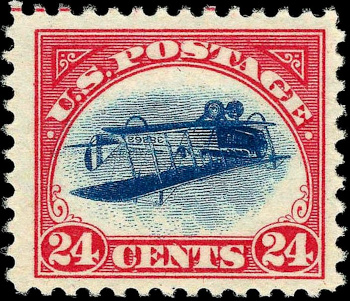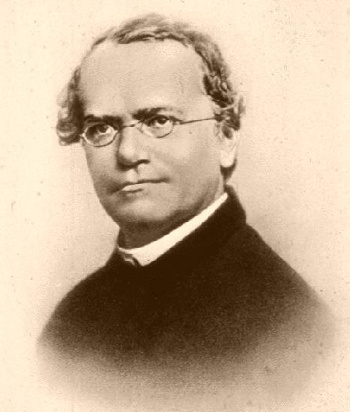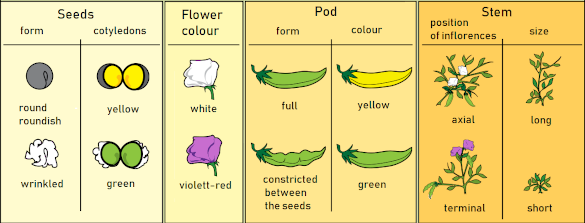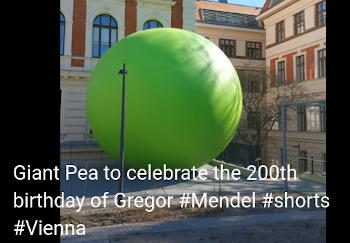Gregor Mendel (1822-1884)
November 28, 2022
Newscasters have helped
humans to
comprehend dimensions far greater than our roughly one meter
size by relating them to familiar things. For
length it's usually the
distance to the
Moon (
average distance 384,400
kilometers, 238,900
miles); for
area it's the
football field (6,400
square yards, 5,351
square meters), or
soccer pitch (7,140 square meters, 8,539 square yards); and, for
volume, it's an
Olympic-size swimming pool (2,500
cubic meters, 3,270
cubic yards, 660,000
US gallons). For smaller quantities, the usual comparisons are to the
width of a human hair (about 75
micrometers), the area of a
postage stamp (very roughly 5
square centimeters), and the volume of a
droplet of water (about 0.05
milliliter).

Worth much more than the paper on which it's printed - The United States Inverted Jenny postage stamp.
This 24 cent United States postage stamp, first issued on May 10, 1918, shows an upside-down image of the Curtiss JN-4 Jennyairplane.
Just a single page of 100 of these stamps was ever found, and a single stamp is valued at about a million dollars.
(Wikimedia Commons image. Click for larger image.)
Some such comparisons are often
ridiculed, such as whether an object is bigger than a
breadbox, a comparison
popularized after its use in a 1953
television game show. The
pea is often used to represent something small in size. The 1835
fairy tale of
The Princess and the Pea by
Hans Christian Andersen (1805-1875) establishes the
exquisite sensitivity of a
princess through her
sensing a pea through multiple
mattresses. This year we
celebrate the importance of the tiny pea in the
history of science. The year, 2022, marked the 200th
anniversary of the
birth of
Gregor Mendel (July 20, 1822 - January 6, 1884), who used the pea
plant to
elucidate some of the first
principles of
genetics.[1-2]
Gregor Mendel (Order of
Saint Augustine, OSA) was an
Augustinian friar and
abbot of
St. Thomas' Abbey, Brno, now in the
Czech Republic (There's an enclave of Augustinians at
Villanova University near
Tikalon's home). Long before Mendel's time, humans practiced natural genetic modification of plants and
animals by sometimes successful
trial and error, as
selective breeding of the
mule, a
donkey-
horse hybrid, illustrates. Mendel's pea plant
experiments in the years 1856-1863 were the first to establish some simple
scientific rules of
heredity, now called the
laws of Mendelian inheritance.[3-4]

Gregor Mendel (July 20, 1822 - January 6, 1884).
He lived and worked on his family farm, which is now a Mendel museum, where he also practiced beekeeping.
One reason that Mendel became a monk is that it enabled him to obtain a free education. Mendel's birth name was Johann, but he was given the name, Gregor, upon becoming a monk.
At the University of Vienna he studied physics under Christian Doppler (1803-1853) of the eponymous Doppler effect.
As a cautionary tale to scientists interested in management, Mendel's scientific work ended as a consequence of his administrative duties when he became abbot in 1868.
(Wikimedia Commons image.)
In his experiments, Mendel demonstrated that when a
true-breeding green pea was
cross-bred with a true-breeding yellow pea, their
offspring always produced yellow
seeds. Interestingly, green peas reappeared 25% of the time in the next
generation. The same principle held true for
flower color, with the first generation of cross-bred white flowered and purple flowered pea plants being all purple-flowered, with the next generation having 25% white flowers.
Mendel defined the
traits of yellow seeds and purple flowers as being
dominant and green seeds and white flowers as being
recessive. His 1866
publication conjectured that there were unknown
factors, now called
genes, that determine such traits of an
organism.[3-4] In 1900, more than three
decades after Mendel's publication, several of his experimental findings were
independently verified, and our
modern age of
genetics had its start. Since the details of Mendel's experiments are still faintly remembered by anyone who's taken a
course in
high school biology, I won't present further
analysis. We've all seen far too many
Mendelian Inheritance diagrams.

Characteristics of pea plants used in Gregor Mendel's inheritance experiments. Mendel decided to use the following easily identified characteristics of pea plants in his experiments: 1) The shape of the ripe seeds, rounded or wrinkled; 2) The color of the seeds and cotyledons (yellow or green); 3) The flower color (white or violet-red); 4) The shape of the ripe pods (inflated or wrinkled); 5) The color of the unripe pods (yellow or green); 6) The position of the flowers (along the stem, or at the top); 7) The length of the stem; and (not shown above) 8) The color of the seed coat (white, gray, or brown, with or without violet spots). (Wikimedia Commons image, modified, by Mariana Ruiz Villarreal. Click for larger image.)
One interesting Mendelian
topic is the
idea that the results of his experiments were too good; that is, he
cooked the numbers to more closely agree with his
hypotheses. This whole
controversy started with a 1936
analysis of Mendel's experiments by noted
statistician and
geneticist,
Ronald Fisher (1890-1962), who wrote that "the data of most, if not all, of the experiments have been
falsified so as to agree closely with Mendel's expectations."[5] This analysis gave rise to the
paradox of why a man of Mendel's supposed
saintly character would do such a thing.
One
explanation would be a
subconscious confirmation bias, and another would be some
data polishing was done to prevent
rejection of publication of the experiments of someone with few scientific
credentials. Our present understanding is that Fisher
underestimated the number of
trials conducted by Mendel to get his results; and, the number of trials is an important factor in
statistics. A 2008
book about the Mendel paradox concluded that Mendel did not fabricate his results.[6]

Giant pea in Vienna to celebrate Gregor Mendel's 200th birthday.
Based on the apparent 12 meter diameter of this pea, I calculated that it could make two million large bowls of pea soup.
(Still image from a YouTube Video.)
References:
- Website for Gregor Mendel's 200 Year Anniversary.
- On the 200th birthday of Gregor Mendel: Leopoldina celebratory symposium on the milestones of modern genetics and its pioneer, press release of the German National Academy of Sciences Leopoldina, July 7, 2022.
- J.G. Mendel, "Versuche über Pflanzenhybriden," Verhandlungen des naturforschenden Vereines in Brünn, Bd. IV für das Jahr, 1865 (1866), pp. 3-47.
- English translation of Ref. 3, "Experiments in plant hybridization", C.T. Druery, and William Bateson, Trans., Journal of the Royal Horticultural Society, vol. 26 (1901), pp. 1-32 (PDF File).
- R.A. Fisher, "Has Mendel's work been rediscovered?" Annals of Science, vol. 1, no. 2(1936), pp. 115-37, DOI:10.1080/00033793600200111. A PDF file can be found pdf here.
- Allan Franklin, A.W.F. Edwards, Daniel J. Fairbanks, and Daniel L. Hartl, "Ending the Mendel-Fisher controversy," University of Pittsburgh Press (Pittsburgh, Pennsylvania: 2008), ISBN 978-0-8229-4319-8. (Summary at Google Books).
Linked Keywords: News presenter; newscaster; human; understanding; comprehend; size; dimensions; length; distance; Moon; lunar distance (astronomy); average distance; kilometer; mile; area; American football field; square yard; square meter; football pitch; soccer pitch; volume; Olympic-size swimming pool; cubic meter; cubic yard; US gallon; width of a human hair; micrometer; postage stamp; square centimeter; drop (unit); droplet of water; milliliter; US Airmail Inverted Jenny Postage Stamp; Worth much more than the paper on which it's printed; United States Postal Service; cent (currency); United States postage stamp; sale; issue; upside-down; image; Curtiss JN-4 Jennyairplane; page (paper); United States dollar; Wikimedia Commons; ridiculous; ridiculed; breadbox; popularity; popularize; television game show; pea; fairy tale; The Princess and the Pea; Hans Christian Andersen (1805-1875); exquisite; stimulus (physiology); sensitivity; princess; sense; sensing; mattress; celebration; celebrate; history of science; anniversary; birth; Gregor Mendel (July 20, 1822 - January 6, 1884); plant; elucidate; physical law; principle; genetics; Augustine of Hippo; Saint Augustine; Augustinian; friar; abbot; St. Thomas' Abbey, Brno; Czech Republic; Villanova University; Tikalon; New Jersey; home; animal; trial and error; selective breeding; mule; donkey; horse; hybrid (biology); experiment; scientific method; laws of science; rule; heredity; laws of Mendelian inheritance; family farm; museum; beekeeping; education; birth name; University of Vienna; physics; Christian Doppler (1803-1853); eponym; eponymous; Doppler effect; cautionary tale; scientist; management; scientific; business administration; administrative duties; Wikimedia Commons; true-breeding organism; crossbreed; cross-bred; offspring; seed; generation; flower; color; phenotypic trait; dominance (genetics); dominant; recessive; scientific literature; publication; conjecture; conjectured; factor; gene; organism; decade; reproducibility; independently verified; modern history; modern age; course (education); high school; biology; analysis; Mendelian Inheritance; diagram; characteristics of pea plants used in Gregor Mendel's inheritance experiments; characteristic; geometry; shape; ripening; ripe; sphere; rounded; wrinkle; wrinkled; cotyledon; flower; pod (plant morphology); inflation; inflated; position; plant stem; apex; top; seed coat; Mariana Ruiz Villarreal; topic; idea; hypothesis; hypotheses; controversy; statistician; geneticist; Ronald Fisher (1890-1962); false; falsified; paradox; saint; saintly; moral character; explanation; subconscious; confirmation bias; data; social rejection; credential; estimation; underestimated; trial (probability theory); statistics; book; Vienna; birthday; meter; diameter; calculation; calculated; bowl; pea soup.